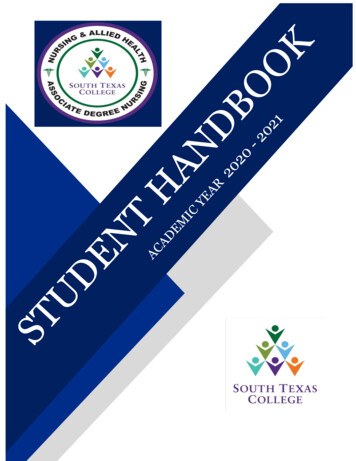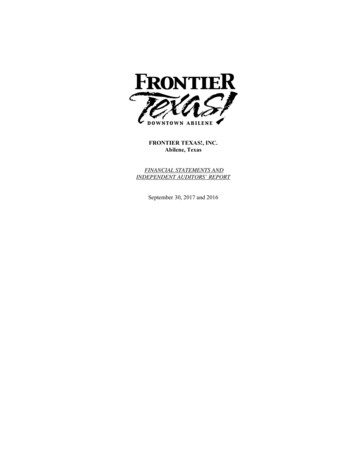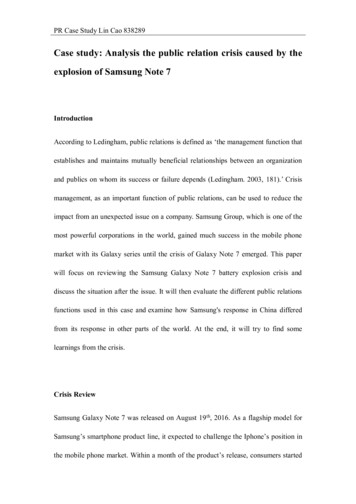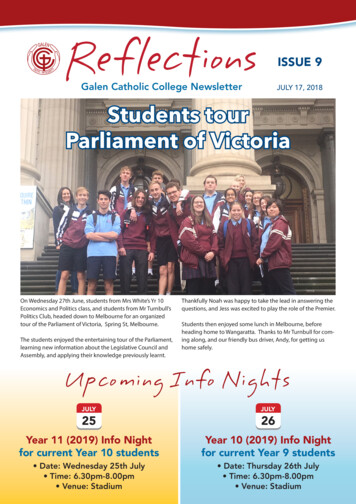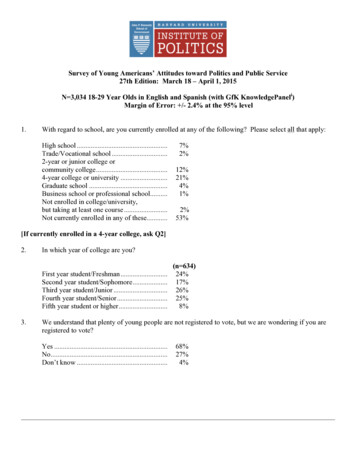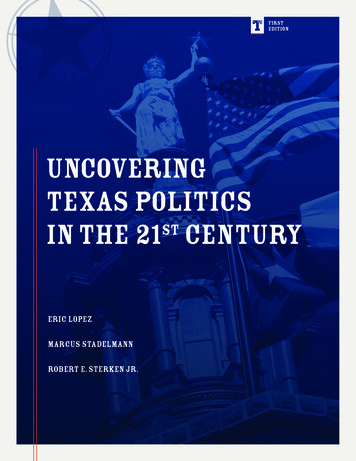
Transcription
firsteditionuncoveringtexas politicsstin the 21 centuryEric LopezMarcus StadelmannRobert E. Sterken Jr.
Uncovering Texas Politicsin the 21st Century
Uncovering Texas Politicsin the 21st CenturyEric LopezMarcus StadelmannRobert E. Sterken Jr.The University of Texas at TylerPRESSTyler, Texas
The University of Texas at TylerMichael Tidwell, PresidentAmir Mirmiran, ProvostNeil Gray, Dean, College of Arts and SciencesUT Tyler PressPublisher: Lucas Roebuck, Vice President for MarketingProduction Supervisor: Olivia Paek, Agency DirectorContent Coordination: Colleen Swain, Associate Provost for Undergraduate and Online EducationAuthor Liaison: Ashley Bill, Executive Director of Academic SuccessEditorial Support: Emily Battle, Senior Editorial SpecialistDesign: Matt Snyder 2020 The University of Texas at Tyler. All rights reserved. This book may be reproduced in itsPDF electronic form for use in an accredited Texas educational institution with permission from thepublisher. For permission, visit www.uttyler.edu/press. Use of chapters, sections or other portionsof this book for educational purposes must include this copyright statement. All other reproductionof any part of this book, storage in a retrieval system, or transmission in any form or by any means,electronic, mechanical, photocopying, recording, or otherwise, except as expressly permitted byapplicable copyright statute or in writing by the publisher, is prohibited.Graphics and images appearing in this book are copyrighted by their respective owners asindicated in captions and used with permission, under fair use laws, or under open source license.ISBN-13978-1-7333299-2-71.1UT Tyler Press3900 University Blvd.Tyler, Texas 75799www.uttyler.edu/press
Table of Contents1323537397117143165193INTRODUCTIONLetter from the ProvostCHAPTER ONEA State of Diversity: Demographics, Culture, and the Struggle for IdentityCHAPTER TWOThe Texas Constitution in the Federal SystemCHAPTER THREEVoting and Elections in TexasCHAPTER FOURPolitical PartiesCHAPTER FIVEInterest GroupsCHAPTER SIXThe Texas LegislatureCHAPTER SEVENThe Executive Branch in TexasCHAPTER EIGHTThe Texas Judicial DepartmentINDEX
Dear Student:This is a great time to live in Texas! Arguably the most influential state in the Union, Texas is an economic,cultural, and educational leader worthy of study. Understanding the dynamic politics of Texas is a greatintroduction to political science. Through the study of political science, students gain insight into their civicrights and responsibilities, empowering them to impactfully participate in the democratic process.At UT Tyler, we believe that providing access to knowledge regardless of means is an important part of ahealthy society. That is why UT Tyler Press is providing the electronic version of Uncovering Texas Politicsin the 21st Century free of charge to Texas students, and the print version at cost. The rising cost of highereducation should not be a barrier to achievement; this free textbook initiative is one way we are working tolower the cost of higher education.The creation of this textbook is funded in part by a grant from the University of Texas System in support ofour Open Educational Resources (OER) initiative to make college more affordable by providing free accessto course materials. I extend our deepest gratitude to UT System for sharing our passion for student successthrough affordable education.Uncovering Texas Politics in the 21st Century is authored by three UT Tyler professors, and their high level ofexpertise and dedication to student learning is evident throughout every chapter.Eric Lopez is a specialist in American politics, the federal court system, and the development of Constitutionallaw. Dr. Marcus Stadelmann is chair of the Department of History and Political Science and teachescomparative politics and international relations. Dr. Robert E. Sterken Jr. is a Senior Fulbright Scholar who hastaught politics around the world, most recently in Burma/Myanmar, Thailand, and Cambodia.On behalf of UT Tyler Press and President Michael Tidwell, I congratulate Drs. Lopez, Stadelmann, andSterken on an excellent textbook, and I again thank UT System for their critical support of this OER project.We hope you find this textbook illuminating and relevant as you progress in your academic career.All the best,uttyler.eduDr. Amir MirmiranProvost, UT TylerI NTR O D U C TI O N L E T T E R F R O M T H E P R OVOS T1
1The People in TexasTexas DemographicsPolitical Culture and Ideologyin a Diverse StateThe capitol building in downtown Austin, Texas.istock.com/Nicolas McComber
Chapter 1A State of Diversity:C H A P T E R 1 A S TAT E O F D I V E R S I T YFIGURE 1.1 Capitol building inAustin, Texas.uttyler.eduTEXAS! What images, stereotypes, and ideas come to mind when you think ofthe Lone Star State? Do you think of the rugged men who fought at the Alamoor of pickup trucks that proudly display “Come and Take It” bumper stickers? Do you think of barbecue, boots, and sadcountry music at the Houston Livestock Show andRodeo? Do you see Texas as the land of oilfields,cowboys, and hardworking super-patriotic peoplewho defy all governmental authority?Whether you have lived in Texas all your lifeor just arrived from Vietnam, you likely pictureTexans as rugged and rowdy people with a fiercestreak of individualism. To some extent, theseimages of Texas are based on reality, but anentirely different picture is woven into these oldstereotypes of Texas culture. The cowboy imageof Texas was always unidimensional and incomplete; it is now far outdated.In Austin, Dallas, El Paso, Houston, Lubbock, Mineola, Nacogdoches, SanAntonio, and Tyler today you will find a cowboy or two driving a pickup truck,but you will also find poets, high-tech business leaders, edgy musicians, superstar athletes, aerospace engineers, fine artists, celebrated professors, andPhoto from Miguel Gutierrez Jr./The Texas TribuneDemographics, Culture, andthe Struggle for Identity3
FIGURE 1.2Top 10 Languages Other than EnglishSpoken in Texas Households, 2017Of the 25 million people in Texas five years or older, 65 percent speak onlyEnglish at home. The rest speak more than 160 languages combined.LanguageNumber of SpeakersSpanish7,498,255Vietnamese214,373Chinese (incl. Mandarin, Cantonese)164,449Tagalog (incl. ench69,428German62,527Korean56,064Source: The American Community Survey 2017¹even world-renowned chefs, all living within a widely diverse set of cultures,languages, people, and foods from every corner of the earth. The stereotypicalimage of Texas embodies a single state of mind and a specific way of life—amonoculture—but this image badly needs an update!The People in TexasToday, Texas is home to immigrants from all over the world. More than165 languages are spoken across the state. Of the estimated 29 millionpeople living in Texas in 2019, about 65% speak only English. A very largemajority—almost 85%—of those who speak another language speak Spanish(Figure 1.2). It might be surprising that Vietnamese is the third most commonlanguage in Texas. The number of Chinese, Urdu, Arabic and Hindi speakershas risen significantly since 2010.Political culture: the set of attitudes,norms, and values that provide theunderlying assumptions and rulesthat govern a society.All this diversity is shaping and reshaping the culture and identity of Texas.In this chapter we will discover not only who makes up the Texas population,but how the diverse population of communities of native Texans, settlers, andimmigrants combine to share and govern the state. The diverse populationuttyler.eduin Texas continues to evolve and is changing the political culture across thestate and in doing so creating tensions and challenges for Texans.4U N COV E R I N G T E X A S P O L I T I C S I N T H E 2 1 S T C E N T U RY
First TexansAll Texans are immigrants because no humans used to live in the land todayknown as Texas.² Although exact dates are lost, we do know there were nonative Texans—people migrated to this region of the world. Tens of thousands of years ago, long before humans began recording history, a landbridge connected the continents of Asia and Alaska. On that land bridge, thefirst human immigrants made their way to North America. When these earlyhumans entered Texas, they had hundreds of thousands of years of evolution and social development behind them. These early people were hunters,cooked with fire, wore fur garments, and made tools of flint and bones. Theseearly immigrants eventually settled in the Valley of Mexico, far south of Texas.In Mexico, a long succession of Aztec, Mayan, Toltec, and other people farmedand grew into a complex and large society. These people developed immensecities, a written form of communication, complex mathematics, and remarkably accurate astronomy. They worked with silver, gold, and copper to createbeautiful art. Over time, farmers in the Mexican valley began to settle and planttheir corn, moving northward. Around 1000 CE, these Mexican (Pueblo) peopleexpanded into the high plains of Texas and then into the Rio Grande Valley.Indigenous PeopleHundreds of groups of native people with various languages, customs, andbeliefs lived on the land that became Texas for at least eleven thousand yearsbefore Europeans arrived. Long before Europeans migrated to Texas, theland was inhabited by descendants of ancient immigrants from Asia and thenfrom Mexico. Over time, the region of Texas became home to many immigranttribes—today we call them Native Americans. Among these Native Americanswere the Caddo people who lived near the Red River in Northeast Texas nearpresent-day Nacogdoches (as well as in Arkansas, Louisiana, and Oklahoma).The Caddo people lived in large complex societies and were known forcultivating corn and for beautiful ceramics. The Apache people lived farthersouth and as far west as Big Bend. While the Caddo were farming, the Apachelived off herds of roaming buffalo. From the rainy woods of East Texas to thehumid Gulf Coast and to the arid plains of West Texas, the native peoplesestablished complex societies, advanced agricultural practices, and organizedspiritual ceremonies and rituals.By the late 17th century, Spanish and French explorers were racing to plantflags across the region that became Texas. The Native Americans and the landin North America meant new labor, natural resources, power, and new sourcesof wealth for Europeans. In 1685, René Robert Cavelier and Sieur de La Salleestablished the first European settlement in Texas.FrenchC H A P T E R 1 A S TAT E O F D I V E R S I T Yuttyler.eduThough ill-fated, La Salle’s Texas settlement gave the French a claim to partsof Texas. By early February in 1685, La Salle had established a colony of about5
FIGURE 1.3Ethnolinguistic Distribution of Native Texans, 1500 and 177615001776Uto-Axtecan LanguageShoshonean LanguageAthapascan LanguageSiouan LanguageCaddoan LanguageTunican LanguageCoahuiltecan LanguageVillageSource: the University of Texas Libraries, The University of Texas at Austinuttyler.edutwo hundred French men, women, and children at Matagorda Bay in Spanish-claimed territory. The French established trade among the Caddo in EastTexas and in 1817, and the French pirate Jean Laffite set up a “republic” onGalveston Island. A year later, Laffite’s Galveston settlement had grown tomore than one thousand French people. The French, like nearly all immigrantswho came to Texas, came in search of better lives, and so contributed muchFrench culture to Texas.The U.S. census of 1860 indicates that there were about two thousandFrench-born people in Texas. By 1930, the U.S. census showed over tenthousand people of French nationality in the state. Every year on July 14th,many Texans celebrate Bastille Day (a celebration of the uprising that beganin the French Revolution). French settlements were abandoned because offood shortages and threats from Spanish authorities. The Spanish worried the6U N COV E R I N G T E X A S P O L I T I C S I N T H E 2 1 S T C E N T U RY
French would ally with the Native Americans to take over the northern Mexicosilver mines, so they sent troops to push out the French.SpanishC H A P T E R 1 A S TAT E O F D I V E R S I T Y» The Spanish colonialsystem envisioneda new society witha paternalisticSpanish-Nativeculture in whichthey would rule,care for, reshape,and profit from thenative people andthe land.uttyler.eduSpanish migrants came seeking gold and silver in a land they thought heldthe fountain of youth. In the 1530s and 1540s, Cabeza de Vaca, Vasquez deCoronado, and Luis de Moscoso Alvarado mapped the area and establishedmissions and military outposts along the Texas coast and throughout easternand northern Texas. Over the next two hundred years, the mission and military outposts administered and controlled the region under Spanish rule.The Spanish conquest in the Americas was not about colonizing or settlingon the land. Spain tightly regulated emigration, and those who did settle didnot expect to live off the land. Rather, they would extract raw resources andlabor from the native population. The brutal Spanish conquest was destructive to the native societies. Beginning with Columbus’s second voyage, theSpanish enslaved alarming numbers of Native Americans to work in gold andsilver mines. By 1520, entire Caribbean islands had been depopulated andthe inhabitants moved to gold mines in what is now the Dominican Republic.Tens of thousands of native Americans were worked to death, even after theSpanish monarchy outlawed slavery. The Spanish colonial system envisioneda new society with a paternalistic Spanish–Native culture in which they wouldrule, care for, reshape, and profit from the native people and the land.This paternalistic approach gave enormous power and responsibility to theCatholic missionary priests and Catholic Church leaders. The Church wouldattempt to spread Christianity and to be the teachers and law-givers across theSpanish colonies. The Church would bring “civilization” to what they saw as“heathen” people. The Spanish people thought saving the souls of heathenswas a very important duty because they believed their religion was the onlytrue path to salvation. For more than a thousand years, however, the nativepeople the Spanish encountered had their own long-cherished and deeplyheld religious traditions. Interestingly, the Caddo and Pueblo people wereopen to the teachings of the Catholic priests, so the Spanish thought that wasa willing acceptance of Catholicism. By the early 1600s, they began reporting to Spain that many native people had been converted to Christianity. Thenative people saw things differently, as they had no intention of letting Christianity take the place of their own religion. The Caddo and Pueblo people wouldaccept and even attend Christian practices, but they did not want nor intend tostop their own practices. The Spanish then demanded that the native peoplestop practicing their own religion. They banned native ceremonies, burnedtheir religious icons, and destroyed their places of worship. The Spanishbecame increasingly brutal, and tensions reached a breaking point in 1675when 47 Pueblo religious leaders were imprisoned in Santa Fe for practicingtheir native religion. The Spanish publicly flogged and then hung three religious leaders. The Pueblo people called for war, and on August 10th, 1680,thousands of Pueblo warriors descended on the Spanish, killing hundreds andspecifically targeting Catholic priests. Religious conflicts with the Spanish and7
the diseases they brought to Texas greatly diminished the Pueblo and Caddosocieties and the numbers of Native Americans. The Spanish empire wouldbecome even more brutal and oppressive, thriving for hundreds of years andreshaping the area’s religion, social structure, culture, and land.Today, much in Texas is shaped by the Spanish. Hundreds of towns, cities,counties, and geographic features across the state have Spanish names. TheTexas legal system is still influenced by a Spanish approach to law and justice.Spanish crops, foods, drinks, livestock and farming techniques are still verymuch part of the culture across Texas. A very large number of Catholics live inTexas, and the Spanish mission architecture still dominates much of the state—especially in Central and West Texas. After a series of revolts, the UnitedMexican States (Mexico) won independence from Spain in 1821. A few yearslater, the Texas revolution began with the battle of Gonzales in October 1835.Tejanosuttyler.eduThe Texas revolution from Mexico ended with the battle of San Jacinto onApril 21, 1836, but over the next decade a tangled series of conflicts over thenext decade—including the United States-Mexican War (1846–1848)—resultedin the United States acquiring about half of Mexico’s territory. Many MexicanTexans, called Tejanos, lived far and wide across the newly acquired territory. The Spanish adjective Tejano (or Tejana) denotes a Texan of Mexicandescent. Tex-Mex is a recently coined adjective related to, but not synonymous with, Tejano.Anglo migrants in Texas clashed with the Tejanos, and the two groupsstruggled for power and to maintain their place in the region. Stephen F.Austin, an early settler who lived in East Texas, organized a small group ofmen called rangers to protect the Anglo immigrants and their property.³ In1835, Texas lawmakers formally instituted Austin’s men as the Texas Rangers.The Texas Rangers worked to ensure that the Anglo immigrants flourished intheir new land, but their success came at the expense of groups they considered enemies and of groups they used for labor. Austin’s men battled Tejanolandowners and the indigenous people, including the Caddo and the Apache.The Texas Rangers targeted the Indian warrior and the Mexican vaquero asenemies of white supremacy.Some Tejanos resisted the newest Texas immigrants with violence. Bythe summer of 1859, Juan Nepomuceno Cortina had come to hate the TexasRangers and the Anglo judges whom he accused of expropriating land fromTejanos who were unfamiliar with the U.S. judicial system. On July 13, 1859,Cortina saw the Brownsville Marshal, Robert Shears, brutally beat and thenarrest a Tejano who Cortina once employed. Cortina shot Marshal Shears androde out of Brownsville with the Tejano prisoner. A couple of months later onSeptember 28, 1859, Cortina rode back into Brownsville, this time with someeighty men. Cortina and his men raced through the streets shouting, “Death tothe Americans!” and “Viva Mexico!” They seized control of the town and shotand killed five men, including the city jailer. Cortina described the Anglo immigrants as “wild beasts” and “vampire guises of men” who murdered Tejanos.8U N COV E R I N G T E X A S P O L I T I C S I N T H E 2 1 S T C E N T U RY
FIGURE 1.4Land Grants and Political Division,1821–1836Capitals of Texas from 1772 to 1836Los Adaes (1722–1773)San Antonio de Bexar (1773–1824)Saltillo (1824–1833)Montclova esTownsMexican land grant boundariesCurrent state boundariesPolitical divisions from 1821-1836Source: the University of Texas Libraries,The University of Texas at AustinCortina’s stand for the Tejanos would earn him an honored spot in Texasmusic. A genre of border ballads is sung by ethnic Mexicans to honor thosewho stand up to discrimination, colonization, and injustice. The Tejanos alsobrought cultural influence in language, literature, art, music, and food to theirnew state.AnglosC H A P T E R 1 A S TAT E O F D I V E R S I T Yuttyler.eduThe Spanish who ruled Texas in the 1790s were very concerned about Anglosfrom the United States migrating into the territory. Anglos rapidly expandedthroughout the United States in the late 1700s and early 1800s, threateningSpanish and, later, Mexican control over Texas. Some Anglos were fugitivesand others were wandering entrepreneurs looking for riches, but most weresubsistence farmers moving into East Texas for the rich rain-soaked soil. TheSpanish were concerned about these American squatters moving into EastTexas without authorization, and they focused on Americans who came intoTexas to steal Texas’s natural resources and sell them in the United States.One enterprising American, Philip Nolan (who immigrated to the UnitedStates from Ireland), was well known to Spanish authorities by 1785. In Octoberof 1800, Nolan presented a map he made of Texas and a bold plan to Baron deCarondelet, the governor of Louisiana, to travel to Texas, capture wild horses,and sell them to a Louisiana regiment. The illegal plan was approved, and9
Nolan set out on his fourth expedition into Spanish Texas with about twentyheavily armed men and a few slaves to capture horses. Near the Brazos River,in the present-day Waco area, Nolan and his men built a small fortificationand corrals for the horses. By March of 1801, Nolan had managed to roundup around three hundred horses. Spanish authorities had been looking forNolan, and the Governor of Texas, Juan Bautista de Elguezabal, issued anorder to “put Nolan out of the way” if he ever returned to Texas.⁴ On the nightof March 21, 1801, a full company of Spanish soldiers from Nacogdoches, underSpanish commander Miguel Francisco Músquiz, surrounded Nolan’s camp andattacked just before sunrise the next morning. Nolan was shot and killed. Themen accompanying Nolan were captured and led to Nacogdoches, where theywere held in the Old Stone Fort (which still stands on the campus of Stephen F.Austin State University). Then, they were taken to Mexico. Nolan is recognizedas the first of many Anglo migrants who eventually took Texas from Spanishand Mexican rule. Because of the surge in illegal Anglo immigration (immigrants like Nolan), the Spanish authorities in Texas decreed laws in the 1830sto stop further immigration into Texas. Eventually, both the illegal Anglo immigrants and the Tejanos called for independence for Texas. Following the TexasRevolution, the relationship between the Tejanos and the Anglos devolvedinto a violent power struggle as the Anglos—now the majority—seized landfrom the Tejanos.⁵Africansuttyler.eduThe first Africans in Texas were slaves. Records show that the Spanish heldAfrican people as slaves in Mexico as early as the 1520s. A slave namedEstevanico is thought to be the first person from Africa to arrive in Texas, buthis migration was not voluntary. In 1528, Estevanico was a slave in a group ofabout eighty Spanish explorers who survived a shipwreck and washed ashoreat Galveston Island. Estevanico was also the first non-Native to visit the Pueblolands in Mexico, where he served as guide for other Spanish expeditions tothe region.Hundreds of thousands of Africans and native Americans were enslavedduring the Spanish empire’s roughly three hundred years in Mexico. Later,Anglo settlers from the United States brought slaves with them as well.Stephen F. Austin’s Rangers used to preserve slave-based agriculture byviolently policing African men and women. The Rangers tracked and punishedenslaved people trying to cross the Rio Grande into Mexico and to freedom. Bythe time of the Texas Revolution in 1836, there were about five thousand Africanslaves in Texas.⁶ By 1850, about thirty-nine thousand slaves were abused tosupport the agrarian economy. Even after slavery was outlawed by the Spanishand then by the Mexican and U.S. governments, people profited from the enterprise by deploying legal terms and frameworks to continue the practice.After the Civil War, the Texas legislature enacted a series of Black Codes thatrestricted the civil rights and freedoms of former slaves and continued slaveryby adopting laws that nullified the intentions of the Thirteenth Amendment,such as convict leasing and vagrancy laws. After Mexico outlawed slavery,10U N COV E R I N G T E X A S P O L I T I C S I N T H E 2 1 S T C E N T U RY
Mexicans used the convict leasing tactic to enslave native Texans. After theU.S. Civil War, Anglo Texans employed the same tactic to continue using slavelabor for profit. These laws also created a violent and new form of slavery thathas again recently come to light.In February 2018 in Sugarland, Texas (a suburb of Houston), a backhoeoperator was preparing ground for the construction of a new school when hesaw something in the dirt. From his tractor seat, it looked like he had uncovered human bones. Bioarchaeologist Dr. Catrina Banks Whitley was immediately called to the site. By June 2018, the remains of 95 bodies—94 men andone woman—had been exhumed. These 95 people recall a violent system ofsocial control from one of the darkest times in Texas’s history.Sugarland, Texas has long been the home of the Imperial Sugar Company,and sugarcane farming prior to the American Civil War relied heavily on slavelabor. After the South’s defeat in the Civil War and the abolition of slavery,sugar plantations could no longer rely on slave labor. Most sugar plantationsin south Texas went bankrupt, but not the Imperial Sugar Company. After theCivil War, Texas leaders and the Imperial Sugar Company turned to a different form of slavery called convict leasing. In the unmarked graves uncovered in Sugarland were the bodies of black Americans targeted and arrestedfor offenses such as vagrancy, flirting with a white woman, or accusations ofpetty theft. African Americans, many who had been slaves, were arrestedand jailed for Jim Crow laws meant to control blacks and “keep them in theirplace.” The African-American people unearthed in Sugarland were convictswho were “leased” to the Imperial Sugar Company. Being arrested and sent toprison in Texas was a horrible and constant fear for African Americans. The 95people exhumed in Sugarland were among the over thirty-five hundred leasedconvicts who died in Texas between 1866 and 1912.In November 2016, thousands of Texans gathered in Austin in front of theCapitol to celebrate the unveiling of a 27-foot-high and 32-foot-wide monument. The monument depicts 48 slaves and marks Juneteenth—June 19,1865—the day Union troops arrived in Texas to free all Texas slaves. Themonument includes other major social, political, and cultural state icons fromyears later. At the unveiling, Texas Governor Greg Abbott said the monumentrecognizes moments in Texas history that have long needed acknowledgment. Governor Abbott said, “To know where we are going in life, we have tounderstand where it is that we have come from. The triumphs, the tragedies,the lessons that we learn along the way. They are a legacy for the generationsthat are to come forward in the future. But chapters have been missing fromthe story of Texas. That changes today.”⁷» By 1850, aboutthirty-nine thousandslaves were abused tosupport the agrarianeconomy. Even afterslavery was outlawedby the Spanish andthen by the Mexicanand U.S. governments,people profited fromthe enterprise bydeploying legal termsand frameworks tocontinue the practice.VietnameseC H A P T E R 1 A S TAT E O F D I V E R S I T Yuttyler.eduIn 2019, the third most common language in Texas was Vietnamese. The U.S.government began its involvement in Vietnam in 1950 with military aid forthe French. In the Vietnam war, U.S. armed forces and South Vietnam foughtagainst the North Vietnamese Army and the Vietcong. U.S. involvement inthe war included hundreds of thousands of U.S. soldiers, large-scale aerial11
FIGURE 1.5Population in Growing States, 2010–2017NumericChange2010 Population2017 Population2010–2017United 7,65310,429,379741,7267.7%North 5%Source: the U.S. Census Bureau’s 2000 and 2010 Census Count, 2017 Population Estimatesuttyler.edubombardment, and the use of napalm over North and South Vietnam thatkilled millions of civilians and hundreds of thousands of soldiers and almosttotally destroyed the small Southeast Asian country.⁸ The fall of Saigon onApril 30, 1975 marked the end of the Vietnam War and the capture of Saigonby North Vietnamese forces. After Saigon’s fall, hundreds of thousands ofVietnamese refugees came to the United States. In the late 1970s and early1980s, many of those refugees made their way to Texas. In 2019, Houstonwas home to more than eighty thousand Vietnamese—the largest populationoutside of California.In 2018, because of its quickly growing Vietnamese population, TarrantCounty (Fort Worth) joined a list of Texas counties required to provide election materials in Vietnamese. The Voting Rights Act, passed in 1965, prohibitsstate and local governments from passing laws or policies that deny Americancitizens the equal right to vote. Part of the Voting Rights Act requires states toprovide registration, voting notices, forms, instructions, assistance, and othermaterials or information relating to the electoral process, including ballots, inlanguages of applicable minority groups in addition to English.⁹ In 2018, TarrantCounty, the third-largest county in Texas, joined Harris County (Houston), thelargest, in translating voting materials into Vietnamese and providing interpreters for Vietnamese-speaking voters.Like the Houston Astros and Texas Rangers baseball teams, the LivestockShow and Rodeo, and the NASA space center, Vietnamese people are nowpart Texas’s identity!¹⁰ Vietnamese Texans have infused new culture and ideasinto the existing Texan population—many speak Vietnamese, celebrate theLunar New Year, and practice Buddhism. On Houston’s Bellaire Boulevard—the12U N COV E R I N G T E X A S P O L I T I C S I N T H E 2 1 S T C E N T U RY
main street of the district
beliefs lived on the land that became Texas for at least eleven thousand years before Europeans arrived. Long before Europeans migrated to Texas, the land was inhabited by descendants of ancient immigrants from Asia and then from Mexico. Over time, the region of Texas became home to m
